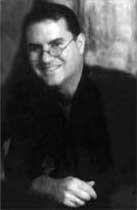
introducing readers to writers since 1995
February 14, 2005
Author2Author: Jonathan Lyons and Mike Brotherton, pt. 1
by Ron HoganAlthough Jonathan Lyons is currently finishing up an MFA in creative writing, he's already got two of his most important credentials: the science fiction novels Burn and Machina--the latter of which has been nominated for the James Tiptree Jr. Award. Because Machina was first published in an electronic edition, I thought it might be interesting to "introduce" Lyons (via email) to Mike Brotherton, whose debut novel, Star Dragon, just came out in paperback but is also available online as a free download under a Creative Commons license. Mike's day job being what it is, though, the conversation started out on an extra-literary note:
 Jonathan Lyons: Before getting to your novel, I really wanted to get some background on your NASA projects and experiences. We've been following the news on the Titan lander and have been astounded by the photos it's managed to send back. So, Mike, please tell me about your experiences.
Jonathan Lyons: Before getting to your novel, I really wanted to get some background on your NASA projects and experiences. We've been following the news on the Titan lander and have been astounded by the photos it's managed to send back. So, Mike, please tell me about your experiences.
Mike Brotherton: I work on everything related to active galactic nuclei, the most extreme of which are quasars. That is, supermassive black holes at the centers of galaxies chowing down on some fuel. I'm much more observational/experimental than theoretical, and work in every part of the electromagentic spectrum (radio through X-rays). I've used the Hubble Space Telescope (and as I write this, itís a sad week for Hubble, its deathknell probably, with a refurbishment mission cut out of the new NASA budget), the Chandra X-ray Observatory, and a dozen or two other telescopes. I've served on review committees for Hubble, Chandra, the NSF, NASA's Infrared Telescope Facility, etc. I'm an active part of the professional astronomical community. Very recently, my postdoc and I landed just over $800,000 in NASA funding to study a couple of different aspects of quasar science over the next several years.
I'm definitely in the two-career mode here, with astronomy and writing, and hope to pull it off. Gregory Benford is probably the best model for me to follow. While Star Dragon was a finalist for the John W. Campbell award for best science fiction novel, unfortunately I'm pretty far from winning a Nebula like Benford did with Timescape. I'm just hoping to make my two careers synergistic, with the astronomy amplifying my science fiction in particular ways, and my science fiction serving as a vehicle for public outreach/education for the astronomy.
In particular, I used to suffer a form of writer's block, if you will, when it came to writing about things close to my science. My brain was too critical, and I rejected speculative elements too readily. My solution with Star Dragon was to switch to interesting binary stars, which had elements in common with quasars (like accretion disks), but were not things I was so familiar with I had the block. A lot of my early stories were fantasy or science fiction horror. I had to make some effort to play to my hard science fiction strengths.
your PayPal donation
can contribute towards its ongoing publication.